Sunlight & Your Eyes
Understanding the effects of sunlight on your eyes is the first step to a lifetime of healthy vision

Without protection, the sun’s harmful rays can contribute to serious vision problems, including vision loss. Stepping outside your door exposes you to several types of light – both visible and invisible. But not all light is the same, and the potential for damage is different for each type of light.
Long-range, ultraviolet A (UVA) and short-range, ultraviolet B (UVB) rays are the most dangerous forms of light produced by the sun. At 320-400 nm (nanometers, or billionths of a meter) and 290-320 nm, respectively, these powerful rays have wave lengths shorter than visible light, making them invisible to the naked eye. They are considered a major cause of cataracts, eyelid cancers and certain other skin cancers, and believed to play a part (along with high-energy visible light, which includes blue light, part of the visible light spectrum) in macular degeneration, one of the major causes of vision loss in the U.S. for people over age 60. In addition, UV rays can prematurely wrinkle and age the skin around the eyes.

Some of the latest eye research has implicated HEV light – high-energy visible light in the violet/blue spectrum – as a contributor to the development of cataracts, macular degeneration and other serious eye maladies. HEV falls into the near-UV range, from almost 400 to over 500 nm in the visible spectrum. Blue light, roughly between 440 and 490 nm within the HEV spectrum, can damage the retina overtime, leading to macular degeneration. The retina is the ocular membrane where images are formed and transmitted to the brain; the macula, the region of sharpest vision located near the center of the retina, is the most likely area to be damaged.
Although the eyelid is designed to protect the eye, its skin is exceedingly thin and contains many fragile tissues that may be injured by UV light. Inside the eye, the lens and the cornea, both transparent, filter UV rays, but by doing so for many years, they may become damaged.
This is especially true for the crystalline lens, which through years of UV absorption, turns yellowish and cataractous. The lens is the eye’s transparent focusing mechanism, located between the iris and the vitreous humor. The cornea, the transparent area in front at the outer layer of the eye, admits light and images to the retina.
 Who’s at Risk?
Who’s at Risk?The fairer your skin, the greater your age, and the lighter your eyes, the higher your long-term risk of sun damage to your eyes, especially if your work or recreation involves prolonged sunlight exposure.
Light eyes are at increased risk for skin cancer and some eye diseases because they contain less of the protective pigment melanin. According to the National Cancer Institute’s SEER database, an estimated 2,390 men and women were diagnosed with, and 240 died from, cancers of the eye and orbit in 2008. With their thin and delicate structures, and greater lifetime exposure to the sun than any other part of the body, the eye and surrounding areas are particularly prone to cancers.
The reality is that all of us are susceptible to eye and eyelid cancers or other damage from the sun, and we need to find ways to help protect ourselves on a daily basis, because the damage keeps adding up over time.
 A year round hazard
A year round hazardUVA rays are present no matter what the season or time of day. Reflected glare exists in all seasons as a visual hindrance. The lower height of the sun in the sky during the winter and earlier sunset time, coinciding with rush hour, may make glare a greater winter driving danger.
Glare-induced “blindness”
Because snow and ice are so reflective, there is a risk of up to 85% of the UV (light) rays of the sun being transmitted upward.
Snow “blindness”
Resulting from excess time in the intense reflective light of snow, the condition may damage the cornea for up to a week, cause eye pain, extreme sensitivity to light and the sensation of having sand in your eye.
Increased UV susceptibility
Winter conditions make eyes even more susceptible to UV damage. Humidity is lower and eyes can tend to dehydrate. Wind also dehydrates and irritates the eyes. The thin clouds and haze of winter also do not absorb UV rays as well as thick, dark, heavy clouds.